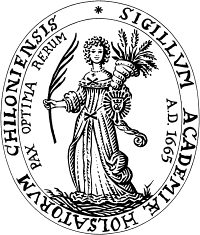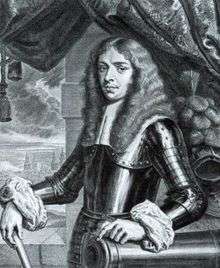University of Kiel
| Christian-Albrechts-Universität zu Kiel | |
 Seal of the University of Kiel | |
|
Latin: Academia Holsatorum Chiloniensis sive Christiana Albertina | |
| Motto | Pax optima rerum |
|---|---|
Motto in English | Peace is the greatest good |
| Type | Public |
| Established | 1665 |
| Budget | € 167.1 million[1] |
| President | Lutz Kipp |
Academic staff | 1,162[2] |
Administrative staff | 1,129[2] |
| Students | 25,277[3] |
| Location | Kiel, Schleswig-Holstein, Germany |
| Campus | Urban |
| Colors |
Purple and white |
| Website | www.uni-kiel.de |
The University of Kiel (German: Christian-Albrechts-Universität zu Kiel, CAU) is a university in the city of Kiel, Germany. It was founded in 1665 as the Academia Holsatorum Chiloniensis by Christian Albert, Duke of Holstein-Gottorp and has approximately 26,000 students today. The University of Kiel is the largest, oldest, and most prestigious in the state of Schleswig-Holstein. Until 1864/66 it was not only the northernmost university in Germany but at the same time the 2nd largest university of Denmark. Faculty, alumni, and researchers of the University of Kiel have won 12 Nobel Prizes. The University of Kiel is a member of the German Universities Excellence Initiative since 2006. The Cluster of Excellence The Future Ocean, which was established in cooperation with the GEOMAR Helmholtz Centre for Ocean Research Kiel in 2006, is internationally recognized. The second Cluster of Excellence "Inflammation at Interfaces" deals with chronic inflammatory diseases. The world-renowned Kiel Institute for the World Economy is also affiliated with the University of Kiel.
History

The University of Kiel was founded under the name Christiana Albertina on 5 October 1665 by Christian Albert, Duke of Holstein-Gottorp. The citizens of the city of Kiel were initially quite sceptical about the upcoming influx of students, thinking that these could be "quite a pest with their gluttony, heavy drinking and their questionable character" (German: mit Fressen, Sauffen und allerley leichtfertigem Wesen sehr ärgerlich seyn). But those in the city who envisioned economic advantages of a university in the city won, and Kiel thus became the northernmost university in the German Holy Roman Empire.
After 1773, when Kiel had come under Danish rule, the university began to thrive, and when Kiel became part of Prussia in the year 1867, the university grew rapidly in size. The university opened one of the first botanical gardens in Germany (now the Alter Botanischer Garten Kiel), and Martin Gropius designed many of the new buildings needed to teach the growing number of students.
The Christiana Albertina was one of the first German universities to obey the Gleichschaltung in 1933 and agreed to remove many professors and students from the school, for instance Ferdinand Tönnies or Felix Jacoby. During World War II, the University of Kiel suffered heavy damage, therefore it was later rebuilt at a different location with only a few of the older buildings housing the medical school.
Faculties

- Faculty of Theology
- Faculty of Law
- Faculty of Business, Economics and Social Sciences
- Faculty of Medicine
- Faculty of Arts and Humanities
- Faculty of Mathematics and Natural Sciences
- Faculty of Agricultural Science and Nutrition
- Faculty of Engineering
Notable people
Alumni
- See also Category:University of Kiel alumni
- Franz Boas (1858–1942), anthropologist
- Alice Bota (born 1979), journalist
- Gerhard Domagk, bacteriologist, Nobel laureate
- Gerhard Stoltenberg, politician, former prime minister of Schleswig-Holstein, former finance minister of Germany
- Peer Steinbrück, politician, former prime minister of North Rhine Westphalia, former finance minister of Germany
- Erich Walter Sternberg, composer
- Wolfgang Kubicki, politician, vice chairman of the FDP in Germany, from 1992 to 1993 and since 1996 he is faction leader of the FDP in the Landtag, the parliament of Schleswig-Holstein, former member of the Bundestag
- Prof. Dr. Doris König, current judge of the Federal Constitutional Court of Germany, Germany's highest court
- Dr. Sibylle Kessal-Wulf, current judge of the Federal Constitutional Court of Germany, Germany's highest court
Academics
- See also Category:University of Kiel faculty
Nobel Prize Winners

There are several Nobel Prize Winners affiliated with the University of Kiel, including:
- 1902 Theodor Mommsen (Literature)
- 1905 Philipp Lenard (Physics)
- 1907 Eduard Buchner (Chemistry)
- 1918 Max Planck (Physics)
- 1922 Otto Meyerhof (Medicine)
- 1939 Gerhard Domagk (Medicine)
- 1950 Kurt Alder and Otto Diels (Chemistry).
Points of interest
See also
References
- ↑ "Die Christian-Albrechts-Universität in Zahlen 2013" (PDF). Universität zu Kiel (in German). p. 19. Retrieved 2017-06-14.
- 1 2 "Die Christian-Albrechts-Universität in Zahlen 2013" (PDF). Universität zu Kiel (in German). p. 18. Retrieved 2017-06-14.
- ↑ "Statistische Eckdaten". University of Kiel (in German). Retrieved 2017-06-14.
- ↑ "SwRI Radiation Assessment Detector (RAD) Homepage". Southwest Research Institute. Retrieved January 19, 2011.
External links
| Wikimedia Commons has media related to University of Kiel. |
- University of Kiel Web site
- University of Kiel International Affairs
- Students' Association at University of Kiel (in German)
Coordinates: 54°20′20″N 10°07′21″E / 54.33889°N 10.12250°E